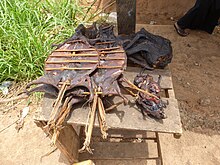 Bushmeat seen on the roadside in Ghana: includes cane rat, giant pouched rat, and red-flanked duiker. | |
| Alternative names | Wild meat, wild game |
|---|---|
| Main ingredients | Wildlife |
Bushmeat is meat from wildlife species that are hunted for human consumption. Bushmeat represents a primary source of animal protein and a cash-earning commodity in poor and rural communities of humid tropical forest regions of the world.[1][2]
The numbers of animals killed and traded as bushmeat in the 1990s in West and Central Africa were thought to be unsustainable.[3] By 2005, commercial harvesting and trading of bushmeat was considered a threat to biodiversity.[4] As of 2016, 301 terrestrial mammals were threatened with extinction due to hunting for bushmeat including non-human primates, even-toed ungulates, bats, diprotodont marsupials, rodents and carnivores occurring in developing countries.[5]
Bushmeat provides increased opportunity for transmission of several zoonotic viruses from animal hosts to humans, such as Ebolavirus and HIV.[6][7][8]
- ^ Nasi, R.; Brown, D.; Wilkie, D.; Bennett, E.; Tutin, C.; Van Tol, G. & Christophersen, T. (2008). Conservation and use of wildlife-based resources: the bushmeat crisis (PDF). CBD Technical Series no. 33. Montreal and Bogor: Secretariat of the Convention on Biological Diversity and Center for International Forestry Research (CIFOR). pp. 1–50.
- ^ Bennett, E. L.; Blencowe, E.; Brandon, K.; Brown, D.; Burn, R. W.; Cowlishaw, G.; Davies, G.; Dublin, H.; Fa, J. E.; Milner-Gulland, E. J.; Robinson, J. G.; Rowcliffe, J. M.; Underwood, F. M. & Wilkie, D. S. (2007). "Hunting for consensus: reconciling bushmeat harvest, conservation, and development policy in West and Central Africa". Conservation Biology. 21 (3): 884–887. Bibcode:2007ConBi..21..884B. doi:10.1111/j.1523-1739.2006.00595.x. PMID 17531066. S2CID 38428707.
- ^ Bowen-Jones, E. & Pendry, S. (1999). "The threats to primates and other mammals from the bushmeat trade in Africa and how this could be diminished". Oryx. 33 (3): 233–247. doi:10.1046/j.1365-3008.1999.00066.x.
- ^ Cowlishaw, G.; Mendelson, S. & Rowcliffe, J. (2005). "Evidence for post-depletion sustainability in a mature bushmeat market". Journal of Applied Ecology. 42 (3): 460–468. Bibcode:2005JApEc..42..460C. doi:10.1111/j.1365-2664.2005.01046.x.
- ^ Ripple, W. J.; Abernethy, K.; Betts, M. G.; Chapron, G.; Dirzo, R.; Galetti, M.; Levi, T.; Lindsey, P. A.; Macdonald, D. W.; Machovina, B.; Newsome, T. M.; Peres, C. A.; Wallach, A. D.; Wolf, C. & Young, H. (2016). "Bushmeat hunting and extinction risk to the world's mammals". Royal Society Open Science. 3 (10): 160498. Bibcode:2016RSOS....360498R. doi:10.1098/rsos.160498. PMC 5098989. PMID 27853564.
- ^ Georges-Courbot, M. C.; Sanchez, A.; Lu, C. Y.; Baize, S.; Leroy, E.; Lansout-Soukate, J.; Tévi-Bénissan, C.; Georges, A. J.; Trappier, S. G.; Zaki, S. R.; Swanepoel, R.; Leman, P. A.; Rollin, P. E.; Peters, C. J.; Nichol, S. T. & Ksiazek, T. G. (1997). "Isolation and phylogenetic characterization of Ebola viruses causing different outbreaks in Gabon". Emerging Infectious Diseases. 3 (1): 59–62. doi:10.3201/eid0301.970107. PMC 2627600. PMID 9126445.
- ^ McMichael, A. J. (2002). "Population, environment, disease, and survival: past patterns, uncertain futures" (PDF). The Lancet. 359 (9312): 1145–1148. doi:10.1016/s0140-6736(02)08164-3. PMID 11943282. S2CID 9159650.
- ^ Karesh, W. B. & Noble, E. (2009). "The bushmeat trade: Increased opportunities for transmission of zoonotic disease". Mount Sinai Journal of Medicine: A Journal of Translational and Personalized Medicine. 76 (5): 429–444. doi:10.1002/msj.20139. PMID 19787649.